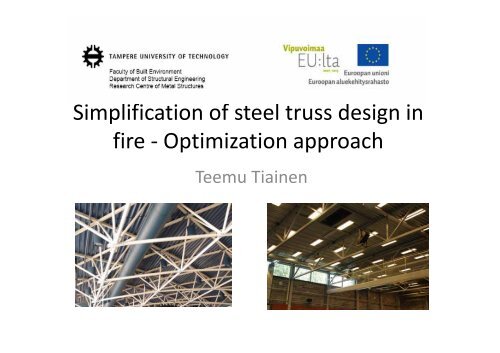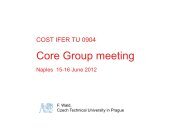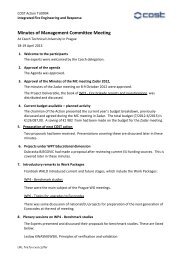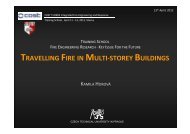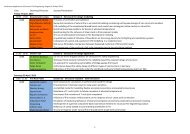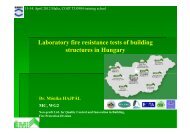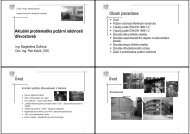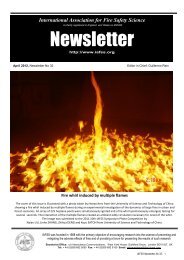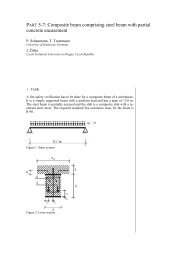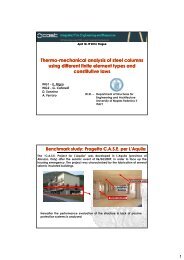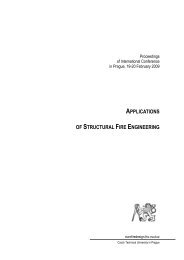Teemu Tiainen
Teemu Tiainen
Teemu Tiainen
Create successful ePaper yourself
Turn your PDF publications into a flip-book with our unique Google optimized e-Paper software.
Simplification of steel truss design in<br />
fire ‐ Optimization approach<br />
<strong>Teemu</strong> <strong>Tiainen</strong>
Steel trusses and optimization –<br />
Motivation and background<br />
• Widely used light weight,<br />
cost effective and aesthetic<br />
structures<br />
• By applying mathematical<br />
optimization techniques<br />
performance could be<br />
enhanced further
What is mathematical optimization?<br />
• Find the design satisfying<br />
the constraints leading<br />
to minimal objective<br />
value<br />
• Algorithms can be<br />
applied to many kinds of<br />
(engineering) problems<br />
Figure above from: Arora, J. S., Burns, S. & Huang, M. W. (1997). What is<br />
optimization? In J. S. Arora (Ed.), Guide to structural optimization, ASCE<br />
Manual on Engineering Practice, No. 90 (pp.1‐23). Reston, VA: American<br />
Society of Civil Engineers
Why optimize and why not?<br />
+ Design problem goals better defined<br />
+ Transparency to decision making<br />
+ Better desings<br />
‐ Problem formulation takes time<br />
‐ Setting up a system capable of doing<br />
necessary calculation takes also time
Truss problem formulation<br />
• Choise of objective function (weight, cost,<br />
enviromental impact etc.)<br />
• Choise of constraints<br />
‐ Stresses and deformations<br />
‐ Building code requirements<br />
‐ Other (manufacturing, architecture etc.)<br />
• Choise of design variables
Truss optimization approaches (1/2)<br />
Sizing<br />
(Choice of<br />
member profiles)<br />
Geometry<br />
(dimensions of truss)
Truss optimization approaches (2/2)<br />
Topology<br />
Other possible<br />
variables:<br />
‐Connections (stiffness,<br />
resistance, cost)<br />
‐Material strength<br />
(S355,S420 etc.)<br />
‐Intumescent paint or<br />
other protection?
Current situation<br />
• Classical approaches of structural optimization<br />
have been researched widely from the 1960s<br />
• Lately building code requirements have been<br />
replacing simple stress and deformation<br />
constraints and construction cost has become<br />
the objective instead of weight<br />
• Still, performance at elevated temperatures is<br />
rarely considered in optimization literature
Main goals of the research<br />
• Include fire design in steel truss optimization<br />
and see if it works<br />
• If so, find out design guidelines leading to<br />
more cost effective or otherwise better<br />
designs
Truss optimization challenges<br />
• The number of variables is<br />
high<br />
• Optimization problems are<br />
most often non‐linear mixed<br />
integer problems => method<br />
must be chosen carefully<br />
• In a single optimization run,<br />
the truss has to be evaluated<br />
thousands of times => fast<br />
evaluation needed (seconds)
Truss evaluation in optimization<br />
?
Elevated temperature design<br />
challenges<br />
• Large deformations<br />
• Elognation of members causes stresses and<br />
deformations (for hyperstatic trusses)<br />
• Geometrical and material non‐linearities<br />
• Possible new buckling modes<br />
=> Special methods must be utilized
Some possible approaches<br />
• Advanced temperature and structural analyses<br />
‐ implementation laborious and requires<br />
commercial programs<br />
‐ accurate but analysis takes time<br />
• Eurocode approach (weakened material<br />
properties, simplified temperature analysis, ISO<br />
fire) with linear beam FEA<br />
‐ implementation fairly easy<br />
‐ fast evaluation<br />
‐ accuracy with non‐uniform temperature<br />
distribution?
Future studies, open questions<br />
• Reliability of EC‐based fire design?<br />
• Multiobjective approach (safety vs. cost vs.<br />
sustainability)<br />
• Connections?


